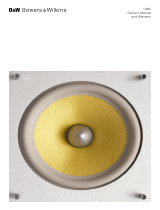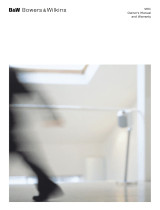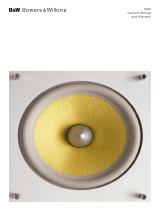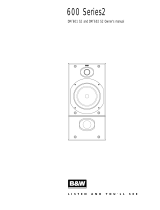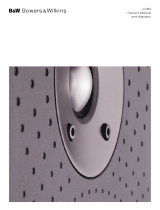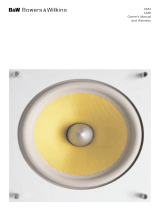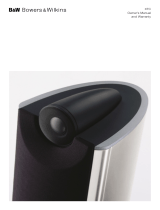Page is loading ...

600 Series
685
686
Owner’s Manual

English
Owner’s manual
Dear customer,
Thank you for choosing B&W. Please read this manual
f
ully before unpacking and installing the product. It will
help you to optimise its performance. B&W maintains
a network of dedicated distributors in over
6
0 countries who will be able to help you should you
have any problems your dealer cannot resolve.
Environmental Information
B&W pro
ducts are designed to comply with
international directives on the Restriction of
H
azardous Substances (RoHS) in electrical and
electronic equipment and the disposal of Waste
Electrical and Electronic Equipment (WEEE). The
crossed wheelie bin symbol indicates compliance and
that the products must be appropriately recycled or
processed in accordance with these directives.
Carton Contents
Check in the carton for:
2 Foam plugs
8 Self-adhesive rubber pads
4 Self-adhesive rubber stand-offs
Speaker Installation
The speakers are best used mounted on rigid floor-
stands that locate the tweeters approximately at ear
level when seated. Shelf or wall bracket mounting is an
option but it provides less opportunity for optimising
the sound through adjustment of speaker position.
If the speakers are to be stood on a shelf or furniture
unit the adhesive pads supplied may be used.
The speakers can be mounted on walls using either
the "keyhole" aperture hardware already attached to
their back panels or by employing ball-joint style
speaker mounting brackets designed for 60mm
(2.36 in) mounting hole centres. If the keyhole
hardware is employed, the rubber pads supplied in the
accessory pack may be used to cushion the speakers
against the wall. Ball-joint style brackets allow the
speakers to be angled with respect to the wall. You
should ensure that the ball-joint brackets are capable
of supporting the weight of the speaker. Your dealer or
local B&W distributor will be able to advise you on the
selection of appropriate ball-joint brackets.
To attach a ball-joint style bracket to a 686 speaker,
remove the bracket hardware from the back panel of
the speaker and securely attach it via the keyhole
aperture to the ball component of the bracket. Re-
attach the bracket and ball assembly to the back
panel. Figure 2a illustrates this procedure.
To attach a ball-joint style bracket to a 685 speaker,
remove the bracket hardware from the back panel of
the speaker and secur
ely attach the ball joint plate
component in its place. Figure 2b illustrates this
procedure.
O
nce the ball joint component is attached to the
speaker, the assembly may be connected to the
s
ocket component attached to the wall. Ensure that
the Manufacturer’s instructions for attaching the
b
racket to the wall are followed correctly.
I
f either keyhole or ball-joint style solutions are used,
e
nsure that the wall fixings are sufficient to hold the
weight of the speakers. B&W can accept no liability for
a
ny failure of wall fixings.
Speaker Positioning
Adjustment of speaker position following initial
i
nstallation will probably further improve the sound
q
uality and is usually worthwhile.
In either stereo or home theatre installations try to
e
nsure that the immediate surroundings of each
speaker are similar in acoustic character. For example,
if one speaker is adjacent to bare walls while the other
is adjacent to soft furnishings and curtains, both the
overall sound quality and the stereo image are likely to
be compromised.
Conventional Stereo Systems
To begin with, the speakers should be positioned
between 1.5m (5 ft) and 3m (10 ft) apart at two
corners of an equilateral triangle completed by the
listening area at the third corner. The speakers should
be approximately 0.5m (20 in) away from the back
wall, and at least 0.5m (20 in) away from any side
walls. Figure 1a illustrates this arrangement.
Home Theatre Systems
If the speakers are to be used for the front channels in
a home theatre system they should be placed closer
together than for 2-channel audio because the
surround channels tend to widen the image.
Positioning the speakers within approximately 0.5m
(20 in) of the sides of the screen will also help keep
the sound image in scale with the visual image. The
speakers’ height should be somewhere between the
centre of the screen and the height of the centre
speaker. As with conventional stereo positioning, the
speakers should ideally be approximately 0.5m (20 in)
away from the back wall, and at least 0.5m (20 in)
away from any side walls.
If the speakers are to be used for the surround
channels in a home theatre system position them as
illustrated in Figures 1c to 1e according to the number
of channels. To achieve even coverage over an
extended listening ar
ea it is beneficial to raise the
speakers above ear height.
Stray Magnetic Fields
The speaker drive units cr
eate stray magnetic fields
that extend beyond the boundaries of the cabinet. We
r
ecommend you keep magnetically sensitive articles
(CRT television and computer screens, computer
discs, audio and video tapes, swipe cards and the
like) at least 0.5m (20 in) fr
om the speaker
. LCD and
plasma screens are not affected by magnetic fields.
2
685_686 OM Inside Iss3.qxd 16/2/07 2:14 pm Page 2

Connections
All connections should be made with the equipment
s
witched off.
T
here are 2 linked pairs of terminals on the back of the
speaker. For conventional connection the terminal links
should remain in place (as delivered) and just one pair
o
f terminals connected to the amplifier. For bi-wire
connection the terminal links should be removed and
e
ach pair of terminals connected to the amplifier
independently. Bi-wiring can improve the resolution of
low-frequency detail. Figures 3a and 3b illustrate
c
onventional and bi-wire connection.
E
nsure that positive terminals on the speaker (marked
+
and coloured red) are connected to the positive
o
utput terminal on the amplifier and that negative
t
erminals on the speaker (marked – and coloured
black) are connected to the negative output terminal
on the amplifier. Incorrect connection can result in
poor imaging and loss of bass.
Ask your dealer for advice when selecting speaker
cable. Keep its total impedance below the maximum
recommended in the speaker specification and use a
low inductance cable to avoid attenuation of high
frequencies.
Fine Tuning
Before fine tuning, make sure that all the connections
in the installation are correct and secure.
Moving the speakers further from the walls will
generally reduce the volume of bass. Space behind
the speakers will also help to create an aural
impression of depth. Conversely, moving the speakers
closer to the walls will increase the volume of bass. If
you want to reduce the volume of bass without
moving the speakers further from the wall, fit the foam
plugs in the port tubes as illustrated in Figure 4.
If the bass seems uneven with frequency this will most
probably be due to resonance modes in the listening
room. Even small changes in the position of the
speakers or the listening position can have a profound
effect on how these resonances affect the sound. Try
moving the listening position or locating the speakers
along a different wall. The presence and position of
large pieces of furniture can also influence resonance
modes.
If the central image lacks focus, try moving the
speakers closer together or angling them inward so
that they point at a location just in front of the listening
position. Figure 1b illustrates speakers angled inwards.
If the sound is too bright, increasing the amount of
soft furnishing in the room (heavier curtains for
example) may help balance the sound. Conversely,
r
educing the amount of soft fur
nishing may help
brighten a dull sound.
Some rooms suffer from "flutter echoes" – echoes that
"bounce" between parallel room boundaries. Flutter
echoes can colour the sound of the speakers in the
room. Test for flutter echoes by standing in the middle
of the room and clapping your hands. Flutter echoes
can be r
educed by placing irr
egular shaped items or
n
on-reflective surfaces, bookshelves, rugs or pictures
for example, on one of the offending walls or floor.
E
nsure that the speaker stands are upright and firm on
t
he floor. Use carpet piercing spikes if appropriate and
adjust them to take up any unevenness.
R
unning-in Period
T
he performance of the speaker will change subtly
during the initial listening period. If the speaker has
b
een stored in a cold environment, the damping
compounds and suspension materials of the drive
units will take some time to recover their correct
m
echanical properties. The drive unit suspensions will
a
lso loosen up during the first hours of use. The time
taken for the speaker to achieve its intended
performance will vary depending on previous storage
conditions and how it is used. As a guide, allow up to
a week for the temperature effects to stabilise and
15 hours of average use for the mechanical parts to
attain their intended design characteristics.
However, longer run-in periods (as long as a month)
have been reported and there is evidence to suggest
that this has little to do with the speaker changing and
more to do with the listener getting used to the new
sound. This is especially so with highly revealing
speakers such as these where there may be a
significant increase in the amount of detail compared
with what the listener has previously been used to; the
sound may at first appear too "up front" and perhaps
a little hard. After an extended period of time the
sound will seem to mellow, but without losing clarity
and detail.
Aftercare
The cabinet surfaces usually only require dusting. If
you wish to use an aerosol or other cleaner, remove
the grille first by gently pulling it away from the
cabinet. Spray aerosols onto the cleaning cloth, not
directly onto the product. Test a small area first, as
some cleaning products may damage some of the
surfaces. Avoid products that are abrasive, or contain
acid, alkali or anti-bacterial agents. Do not use
cleaning agents on the drive units. The grille fabric
may be cleaned with a normal clothes brush whilst the
grille is detached from the cabinet. Avoid touching the
drive units, especially the tweeter, as damage may
result.
Limited Warranty
This product has been designed and manufactured to
the highest quality standar
ds. However, if something
does go wrong with this product, B&W Group Ltd. and
its national distributors warrant free of charge labour
(exclusion may apply) and replacement parts in any
country served by an of
ficial B&W distributor
.
This limited warranty is valid for a period of five years
from the date of purchase or two years for electronics
including amplified loudspeakers.
3
685_686 OM Inside Iss3.qxd 16/2/07 2:14 pm Page 3

Terms and Conditions
1 The warranty is limited to the repair of the
e
quipment. Neither transportation, nor any other
costs, nor any risk for removal, transportation and
installation of products is covered by this warranty.
2 This warranty is only valid for the original owner. It
i
s not transferable.
3
This warranty will not be applicable in cases other
than defects in materials and/or workmanship at
t
he time of purchase and will not be applicable:
a
. for damages caused by incorrect installation,
connection or packing,
b. for damages caused by any use other than correct
use described in the user manual, negligence,
m
odifications, or use of parts that are not made or
authorised by B&W,
c. for damages caused by faulty or unsuitable
ancillary equipment,
d. for damages caused by accidents, lightning, water,
fire heat, war, public disturbances or any other
cause beyond the reasonable control of B&W and
its appointed distributors,
e. for products whose serial number has been
altered, deleted, removed or made illegible,
f. if repairs or modifications have been executed by
an unauthorised person.
4 This guarantee complements any national/regional
law obligations of dealers or national distributors
and does not affect your statutory rights as a
customer.
How to claim repairs under warranty
Should service be required, please follow the following
procedure:
1 If the equipment is being used in the country of
purchase, you should contact the B&W authorised
dealer from whom the equipment was purchased.
2 If the equipment is being used outside the country
of purchase, you should contact the B&W national
distributor in the country of residence who will
advise where the equipment can be serviced. You
can call B&W in the UK or visit our web site to get
the contact details of your local distributor.
To validate your warranty, you will need to produce the
warranty booklet completed and stamped by your
dealer on the date of purchase. Alternatively, you will
need the original sales invoice or other proof of
ownership and date of pur
chase.
Français
Manuel d’utilisation
Cher Client,
Nous vous remercions d’avoir choisi B&W. Veuillez lire
s
oigneusement ce manuel avant de déballer et
d’installer vos enceintes acoustiques. Il vous aidera à
en obtenir les performances optimales. B&W est
d
istribué dans plus de 60 pays dans le monde entier,
par l’intermédiaire de distributeurs spécialement
s
électionnés ; ceux-ci pourront vous aider à résoudre
d’éventuels problèmes ignorés par votre revendeur.
Information sur la protection de
l’environnement
Les produits B&W sont conçus en conformité
totale avec les nouvelles normes internationales
concernant l’interdiction d’utilisation de
certaines substances dangereuses (RoHs) dans les
équipements électriques et électroniques, ainsi que la
possibilité de recyclage des matériaux utilisés (WEEE,
pour Waste Electrical and Electronic Equipment). Le
symbole du conteneur à ordures barré par une croix
indique la compatibilité avec ces directives, et le fait
que les appareils peuvent être correctement recyclés
ou traités dans le respect total de ces normes.
Vérification du contenu de l’emballage
Vérifiez que le carton contienne bien :
2 tampons en mousse
8 pieds en caoutchouc auto-adhésifs
4 entretoises en caoutchouc auto-adhésives
Installation des enceintes
Les enceintes seront de préférence montées sur des
pieds de sol rigides, positionnant les tweeters
approximativement à la hauteur des oreilles des
auditeurs assis. L’installation sur des étagères ou via
des supports muraux est une option, qui ne permettra
toutefois pas autant de souplesse quant à
l’optimisation des résultats sonores en fonction de la
position réelle des enceintes.
Si les enceintes doivent être posées sur une étagère
ou un meuble, utilisez les pieds en caoutchouc auto-
adhésifs fournis.
Les enceintes peuvent être fixées au mur en utilisant
simplement le trou de fixation type « trou de serrure »
visible sur leur face arrière, ou par l’intermédiaire de
supports de montage spécifiques orientables, conçus
spécifiquement pour des trous de fixation de 60 mm.
Si la fixation « tr
ou de serrur
e » est utilisée, les
tampons de caoutchouc fournis dans le kit
d’accessoires pourront être utilisés, dans la zone de
contact entre l’enceinte et le mur. Les supports
orientables permettent d’orienter précisément chaque
enceinte quelle que soit la position du mur. Assurez-
vous que les supports choisis sont capables de
supporter le poids de l’enceinte. V
otr
e r
evendeur
agréé B&W vous donnera toutes les informations utiles
sur le choix d’un tel support réellement adapté.
4
685_686 OM Inside Iss3.qxd 16/2/07 2:14 pm Page 4

37
685_686 OM Inside Iss3.qxd 16/2/07 2:14 pm Page 37

38
685_686 OM Inside Iss3.qxd 16/2/07 2:14 pm Page 38

39
685_686 OM Inside Iss3.qxd 16/2/07 2:14 pm Page 39

40
685_686 OM Inside Iss3.qxd 16/2/07 2:14 pm Page 40

41
685_686 OM Inside Iss3.qxd 16/2/07 2:14 pm Page 41

43
685
T
echnical features
Description
Drive units
Frequency range
Frequency response
Dispersion
Sensitivity
Harmonic distortion
Nominal impedance
Crossover frequency
Recommended amplifier power
Max. recommended cable impedance
Dimensions
Net weight
N
autilus
™
t
ube-loaded aluminium dome tweeter
Kevlar
®
brand fibre cone bass/midrange
Flowport
™
2-way vented-box system
1x ø25mm (1 in) aluminium dome high-frequency
1x ø165mm (6.5 in) woven Kevlar
®
cone bass/midrange
-6dB at 42Hz and 50kHz
49Hz - 22kHz ±3dB on reference axis
Within 2dB of reference response
Horizontal: over 60° arc
Vertical: over 10° arc
88dB spl (2.83V, 1m)
2nd and 3rd harmonics (90dB, 1m)
<1% 110Hz - 22kHz
<0.5% 150Hz - 20kHz
8
Ω
(minimum 3.7
Ω
)
4kHz
30W - 100W into 8
Ω
on unclipped programme
0.1
Ω
Height: 340mm (13.4 in) (not including feet)
Width: 198mm (7.8 in)
Depth: 331mm (12.3 in) (including grille and terminals)
7.0kg (15.4 lb)
685_686 OM Inside Iss3.qxd 16/2/07 2:14 pm Page 43

44
686
T
echnical features
Description
Drive units
Frequency range
Frequency response
Dispersion
Sensitivity
Harmonic distortion
Nominal impedance
Crossover frequency
Recommended amplifier power
Max. recommended cable impedance
Dimensions
Net weight
N
autilus
™
t
ube-loaded aluminium dome tweeter
Kevlar
®
brand fibre cone bass/midrange
Flowport
™
2-way vented-box system
1x ø25mm (1 in) aluminium dome high-frequency
1x ø130mm (5 in) woven Kevlar
®
cone bass/midrange
-6dB at 45Hz and 50kHz
55Hz - 22kHz ±3dB on reference axis
Within 2dB of reference response
Horizontal: over 60° arc
Vertical: over 10° arc
84dB spl (2.83V, 1m)
2nd and 3rd harmonics (90dB, 1m)
<1% 110Hz - 22kHz
<0.5% 150Hz - 20kHz
8
Ω
(minimum 5.1
Ω
)
4kHz
30W - 100W into 8
Ω
on unclipped programme
0.1
Ω
Height: 265mm (10.5 in) (not including feet)
Width: 170mm (6.7 in)
Depth: 284mm (11.2 in) (including grille and terminals)
4.9kg (10.8 lb)
685_686 OM Inside Iss3.qxd 16/2/07 2:14 pm Page 44

Kevlar is a registered trademark of DuPont.
Nautilus is a trademark of B&W Group Ltd.
Copyright © B&W Group Ltd. E&OE
Printed in China.
B&W Group (UK Sales)
T +44 1903 221 500
E uksales@bwgroup.com
B&W Group North America
T +1 978 664 2870
E marketing@bwgroupusa.com
B&W Group Asia Ltd
T +852 2 869 9916
E info@bwgroup.hk
B&W Group Ltd
Dale Road
Worthing West Sussex
BN11 2BH England
T +44 (0) 1903 221800
F +44 (0) 1903 221801
info@bwgroup.com
www.bowers-wilkins.com
II11385 Issue 3
/
